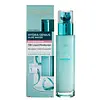The INKEY List Hyaluronic Acid Serum Versus L'Oreal Skin Expert Hydra Genius Aloe Water Dry & Sensitive Skin
What's inside
What's inside
 Key Ingredients
Key Ingredients

 Benefits
Benefits

 Concerns
Concerns

No concerns
 Ingredients Side-by-side
Ingredients Side-by-side

Water
Skin ConditioningPropanediol
SolventSodium Hyaluronate
HumectantGlycerin
HumectantButylene Glycol
HumectantPhenoxyethanol
PreservativeAmmonium Acryloyldimethyltaurate/Vp Copolymer
Leuconostoc/Radish Root Ferment Filtrate
AntimicrobialHyaluronic Acid
HumectantCarbomer
Emulsion StabilisingSodium Lactate
BufferingPolysorbate 20
EmulsifyingPalmitoyl Tetrapeptide-7
Skin ConditioningPalmitoyl Tripeptide-1
Skin ConditioningWater
Skin ConditioningGlycerin
HumectantAlcohol Denat.
AntimicrobialDimethicone
EmollientHydroxyethylpiperazine Ethane Sulfonic Acid
BufferingPentylene Glycol
Skin ConditioningPEG-20 Methyl Glucose Sesquistearate
EmulsifyingPEG-60 Hydrogenated Castor Oil
EmulsifyingSilanetriol
Aloe Barbadensis Leaf Juice
Skin ConditioningSodium Hyaluronate
HumectantSodium Hydroxide
BufferingSilica Dimethyl Silylate
EmollientHyaluronic Acid
HumectantAscorbyl Glucoside
AntioxidantAmmonium Polyacryloyldimethyl Taurate
Emulsion StabilisingDisodium EDTA
Caprylyl Glycol
EmollientCitric Acid
BufferingXanthan Gum
EmulsifyingT-Butyl Alcohol
PerfumingBetula Alba Juice
AstringentEthylhexyl Palmitate
EmollientOctyldodecanol
EmollientButylene Glycol
HumectantHexylene Glycol
EmulsifyingTocopherol
AntioxidantPotassium Sorbate
PreservativeSorbic Acid
PreservativeSodium Benzoate
MaskingPhenoxyethanol
PreservativeCI 42090
Cosmetic ColorantLinalool
PerfumingLimonene
PerfumingParfum
MaskingWater, Glycerin, Alcohol Denat., Dimethicone, Hydroxyethylpiperazine Ethane Sulfonic Acid, Pentylene Glycol, PEG-20 Methyl Glucose Sesquistearate, PEG-60 Hydrogenated Castor Oil, Silanetriol, Aloe Barbadensis Leaf Juice, Sodium Hyaluronate, Sodium Hydroxide, Silica Dimethyl Silylate, Hyaluronic Acid, Ascorbyl Glucoside, Ammonium Polyacryloyldimethyl Taurate, Disodium EDTA, Caprylyl Glycol, Citric Acid, Xanthan Gum, T-Butyl Alcohol, Betula Alba Juice, Ethylhexyl Palmitate, Octyldodecanol, Butylene Glycol, Hexylene Glycol, Tocopherol, Potassium Sorbate, Sorbic Acid, Sodium Benzoate, Phenoxyethanol, CI 42090, Linalool, Limonene, Parfum
 Reviews
Reviews

Ingredients Explained
These ingredients are found in both products.
Ingredients higher up in an ingredient list are typically present in a larger amount.
Butylene Glycol (or BG) is used within cosmetic products for a few different reasons:
Overall, Butylene Glycol is a safe and well-rounded ingredient that works well with other ingredients.
Though this ingredient works well with most skin types, some people with sensitive skin may experience a reaction such as allergic rashes, closed comedones, or itchiness.
Learn more about Butylene GlycolGlycerin is already naturally found in your skin. It helps moisturize and protect your skin.
A study from 2016 found glycerin to be more effective as a humectant than AHAs and hyaluronic acid.
As a humectant, it helps the skin stay hydrated by pulling moisture to your skin. The low molecular weight of glycerin allows it to pull moisture into the deeper layers of your skin.
Hydrated skin improves your skin barrier; Your skin barrier helps protect against irritants and bacteria.
Glycerin has also been found to have antimicrobial and antiviral properties. Due to these properties, glycerin is often used in wound and burn treatments.
In cosmetics, glycerin is usually derived from plants such as soybean or palm. However, it can also be sourced from animals, such as tallow or animal fat.
This ingredient is organic, colorless, odorless, and non-toxic.
Glycerin is the name for this ingredient in American English. British English uses Glycerol/Glycerine.
Learn more about GlycerinHyaluronic acid is naturally found in healthy skin. It is a humectant, meaning it draws moisture to your skin.
This ingredient helps hydrate, soothe, and protect the skin.
What makes hyaluronic acid so hydrating? It has the capacity to bind or hold large amounts of water.
Fun fact: It is already naturally found in our bodies, such as the fluids of our eyes and our joints.
Studies find this ingredient to have anti-inflammatory and anti-microbial properties. This can help speed up wound-healing.
Hyaluronic acid can be irritating if the molecule has a low-molecular weight, or if the molecules are small.
One study found low-molecular weight hyaluronic acid to be pro-inflammatory, meaning some people may experience irritation. This is because our bodies use hyaluronic acid in the wound-healing process to signal to our bodies, via irritation, that something needs healing.
The same study found high-molecular weight hyaluronic acid to be anti-inflammatory.
These are some other common types of Hyaluronic Acid:
Learn more about Hyaluronic AcidPhenoxyethanol is a preservative that has germicide, antimicrobial, and aromatic properties. Studies show that phenoxyethanol can prevent microbial growth. By itself, it has a scent that is similar to that of a rose.
It's often used in formulations along with Caprylyl Glycol to preserve the shelf life of products.
Sodium Hyaluronate is hyaluronic acid's salt form. It is commonly derived from the sodium salt of hyaluronic acid.
Like hyaluronic acid, it is great at holding water and acts as a humectant. This makes it a great skin hydrating ingredient.
Sodium Hyaluronate is naturally occurring in our bodies and is mostly found in eye fluid and joints.
These are some other common types of Hyaluronic Acid:
Learn more about Sodium HyaluronateWater. It's the most common cosmetic ingredient of all. You'll usually see it at the top of ingredient lists, meaning that it makes up the largest part of the product.
So why is it so popular? Water most often acts as a solvent - this means that it helps dissolve other ingredients into the formulation.
You'll also recognize water as that liquid we all need to stay alive. If you see this, drink a glass of water. Stay hydrated!
Learn more about Water